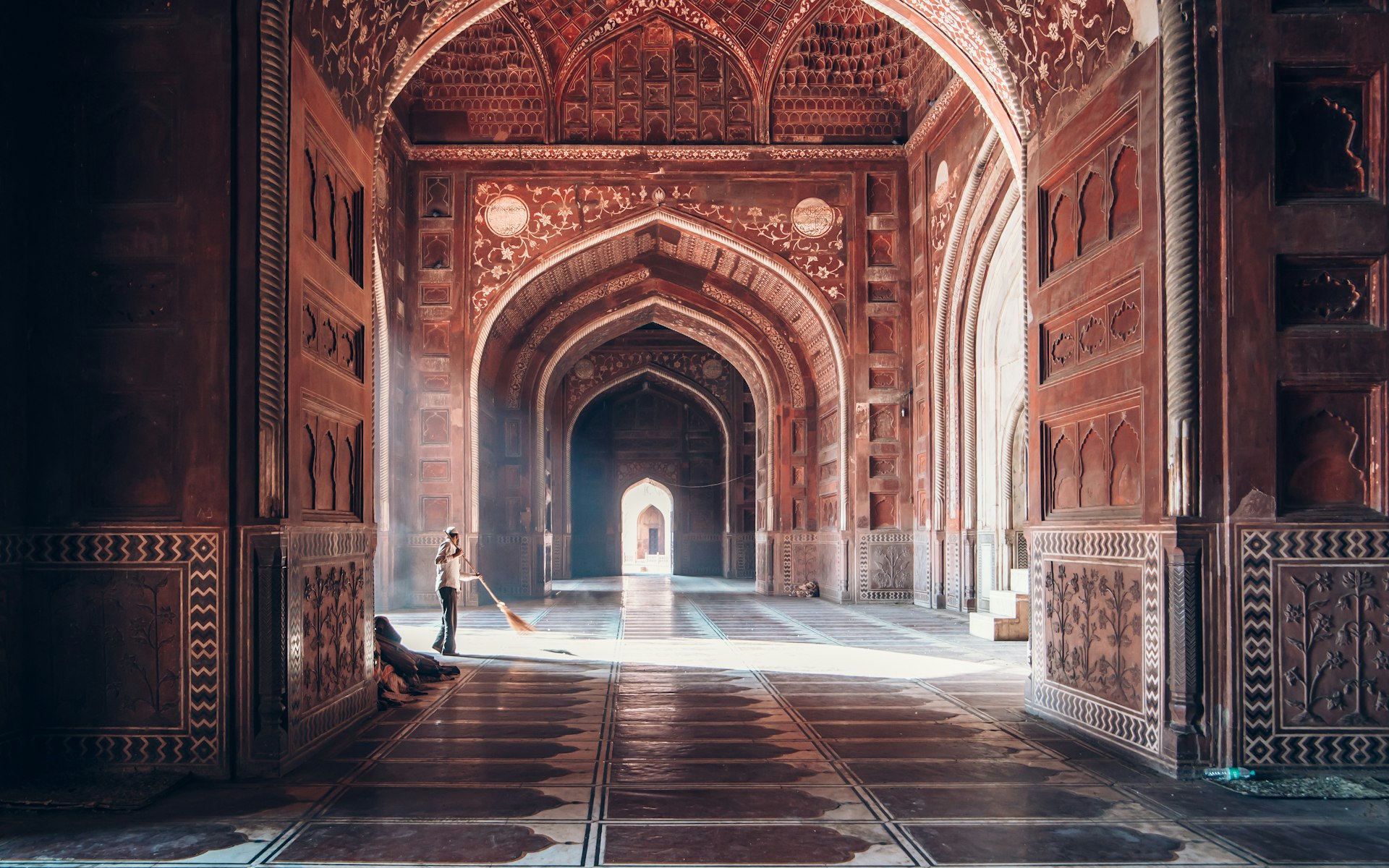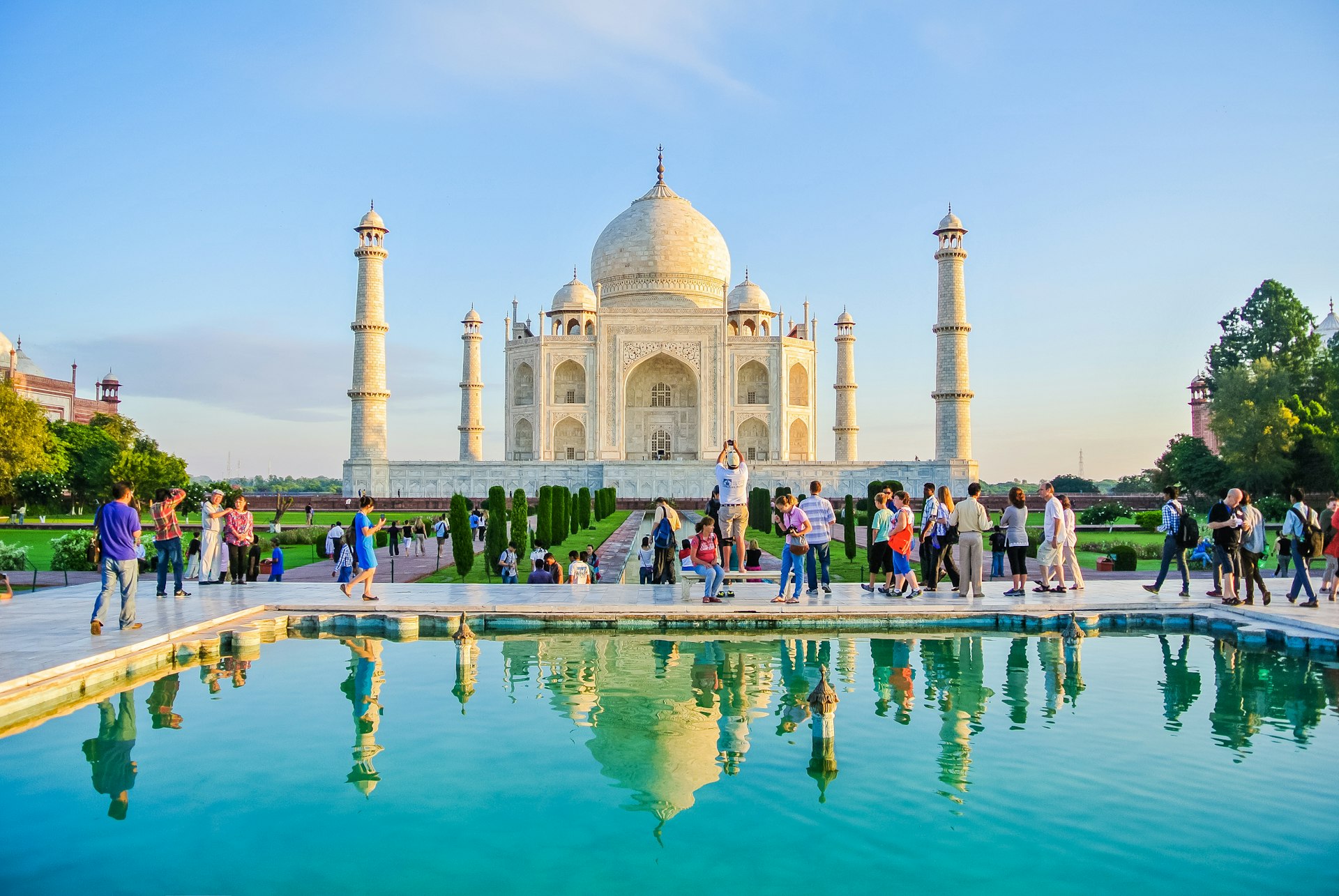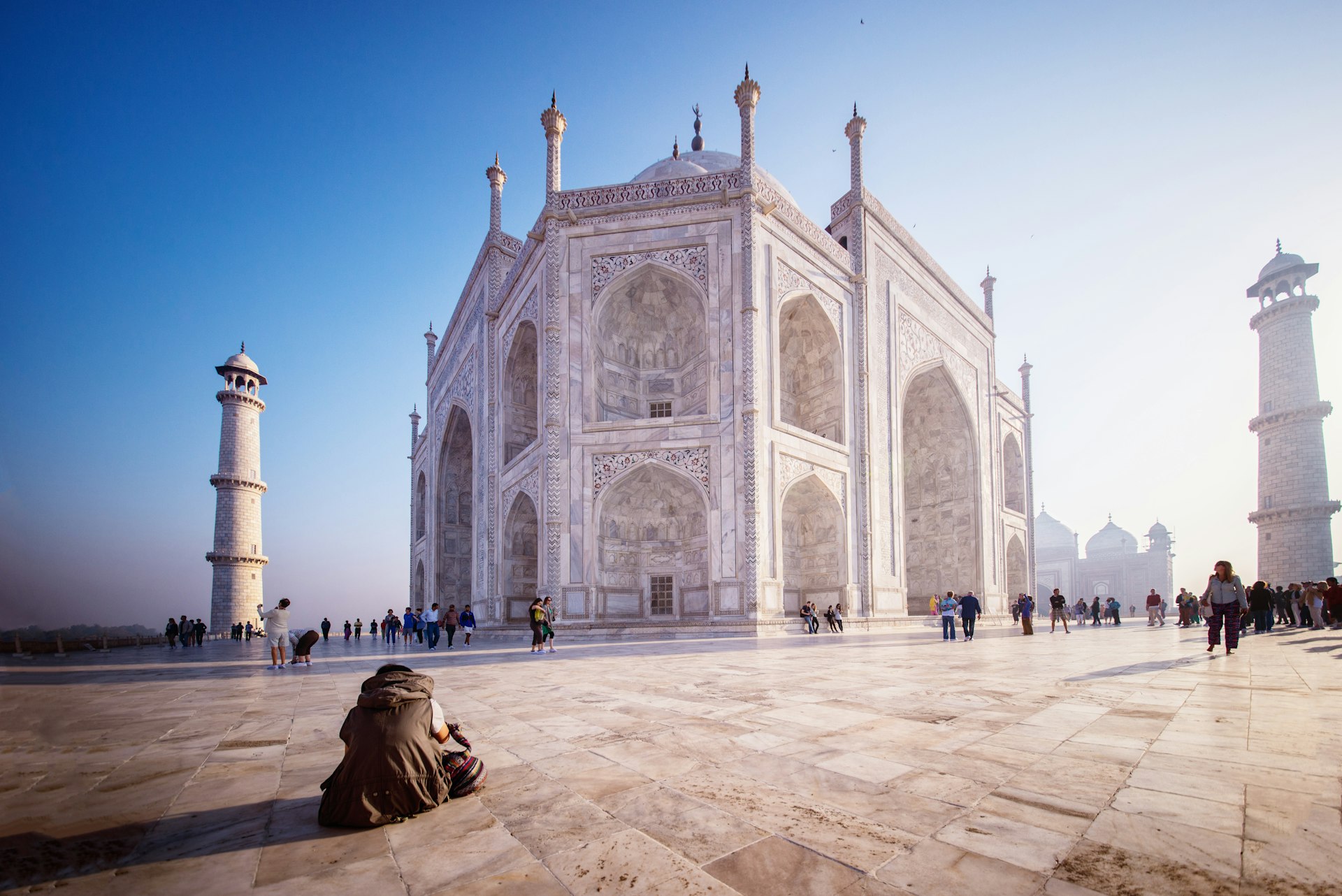There are few sights in the world as iconic as the Taj Mahal. The grandeur of this magnificent monument is equaled only by the tragedy of its backstory – the tomb of a royal bride, created by a mourning emperor, who ended his days robbed of his empire, imprisoned in a gilded cell with a view of this beautiful, tragic mausoleum.
As the single most famous sight in the subcontinent, the Taj is a must-see on most India itineraries, particularly for travelers on the famous Golden Triangle circuit, linking Delhi, Agra, and Jaipur. However, the Taj is mobbed daily by sightseers from across India and around the world, so get used to the idea of sharing the experience.
Here is an introduction to the history and legends surrounding India’s most famous building, and tips for making the trip of a lifetime.
Where is the Taj Mahal?
The Taj Mahal stands in gorgeous Mughal gardens in the Taj Ganj district of Agra, a historic but noisy city of four million people on the hot, dusty plains of Uttar Pradesh in northern India.
Agra has a reputation as a hectic spot, but its historic wonders – not just the Taj, but nearby Agra Fort, and a string of other Mughal monuments – make it worth braving the touts, pollution, and persistent rickshaw drivers.
Agra is well connected by road, rail, and air. The easiest route from Delhi is the 6:55am 12280 Taj Express train, which reaches Agra in just three hours.
What is the Taj Mahal?
The Taj Mahal is often described as the greatest monument built for love, but the Taj Mahal is actually a memorial to tragedy. When Mumtaz Mahal, the chief consort of the Mughal emperor Shah Jahan, died in childbirth in 1631, the heartbroken emperor devoted years and a considerable fortune to constructing a tomb worthy of his great love.
The mausoleum was finally completed in 1648 after years of painstaking chiseling and carving by the most skilled craftspeople in the Mughal empire. The queen consort was interred inside in a private chamber at the heart of the monument and Shah Jahan was later buried alongside his wife when he died in 1666.
The Taj Mahal has many special features
The riverside location reveals a lot
The Taj is tucked into a curve of the Yamuna River, a tributary of the sacred River Ganges, about 1.5km (1 mile) east of Agra Fort. The rediscovery of the “moonlight garden” – built across the river from the tomb but later buried by silt – hints at religious connotations to the Taj’s riverfront location, with the tomb’s eight rooms representing the hasht bihisht (eight paradises) and the Yamuna representing the rivers of milk and honey that wait for the virtuous in the afterlife.
The Taj is built with perfect symmetry
From its gleaming domes and filigree marble screens to its towering minarets, the Taj shows perfect bilateral symmetry along an axis running through the center of the main dome and the surrounding gardens. The only break in symmetry is found in the burial chamber, where the grave of Shah Jahan sits just to one side of the grave of Mumtaz Mahal set at the geometric center of the monument.
The dome is remarkable
The elegant onion-dome atop the Taj Mahal is a perfect illustration of the complex geometry used in Islamic architecture. The base of the dome – which is almost as tall as the building below, and flanked by four smaller domes – is supported by eight angled ogive arches, allowing the transition from a square plan to a circular structure.
The stonemasonry is a masterpiece
While it looks like it was carved from gleaming white marble, the Taj is a masterpiece of stone facing. Entombed behind intricately carved marble panels and perforated screens is a brick-and-lime mortar skeleton, but it cannot be glimpsed from any of the open areas of the monument. For insights into this style of Mughal architecture, check out Khan-i-Khanan’s Tomb in Delhi, which was stripped of its sandstone and marble veneer to build a tomb for a higher ranking Mughal dignitary.
The Taj is covered in magnificent ornamentation
The Taj isn’t the only Mughal monument to feature pietra dura – intricate inlay work, made from semi-precious stones – but it is unquestionably the finest. While it shines brilliant white from a distance, up close the Taj is adorned with an elegant tracery of filigree scrollwork, leaves, flowers and Islamic motifs, executed in marble, jasper, lapis lazuli, carnelian, malachite, and other colored stones.

Cultured calligraphy covers the four pishtaqs
The four pishtaqs (arched recesses) on the four sides of the Taj are framed by passages from the Quran in intricate calligraphy made from strips of jasper inlaid into marble panels. The script increases in size as it climbs the walls of the monument, but appears to be a uniform size when viewed from the ground – a testament to the complex architectural understanding of the craftspeople who built it.
The gardens are heavenly
Everyone has seen the photos of world leaders posed at the end of the ornamental ponds in front of the Taj. Both the main gardens inside the complex and the so-called moonlight garden on the north bank of the Yamuna River are built to mirror the charbagh, the four gardens of heaven. Note the influence of Islamic geometry – flowerbeds are shaped like the rub el hizb (Islamic star) and water features split each quarter of the gardens into four equal parts.
Shah Jahan and Mumtaz Mahal’s graves are elsewhere
While the inlaid marble cenotaphs of the royal couple stand in an elegant space beneath the main dome, shielded by an octagonal perforated screen, these do not contain the bodies of Shah Jahan and Mumtaz. The actual graves of the emperor and his wife are hidden in an underground vault that has been closed to the public since the tomb was constructed.
The minarets are deliberately angled
Although they were never used for this purpose, the four towers marking the corners of the tomb were built as working minarets, with stairways and balconies allowing a muezzin to call the faithful to prayer. If you look closely, you’ll notice that the minarets are angled slightly outwards, allowing the towers to collapse away from the mausoleum in the event of an earthquake.
The Taj is flanked by a mosque and its mirror image
To the west of the main mausoleum is an elegant red sandstone mosque that is still in use today, with two low minarets that sit almost flush with its roofline, so as not to distract from the grandeur of the Taj. The identical building on the east side of the tomb was constructed purely for symmetry; it was not suitable for prayer as it faces away from Mecca.
The building’s exterior is discolored due to pollution
The Taj still shimmers like it did in 1648, but up close, you may notice a yellow, green, and brown sheen, caused by toxic pollution from heavy industry and vehicle emissions in Agra. Despite government schemes to close factories and reduce traffic in the area around the Taj, and several attempts to clean the marble with “face packs” made from a fine clay that absorbs stains and other pollutants, the problem persists. In 2018, the Supreme Court issued an ultimatum to the Indian government to properly restore the Taj, or demolish it! In response, the Archaeological Survey of India announced a six-month program of mud-pack facials for the main dome in October 2021.
The Taj has often been copied, but never equalled
Copies of the Taj Mahal have been built around the world. Constructed by Aurangzeb’s son Azam Shah in 1679, the Bibi-qa-Maqbara in Aurangabad, is an obvious tribute to the Taj, though much less refined. There are also modern reproductions of the Taj Mahal in Bangladesh, China, Indonesia, Malaysia, the US, Brazil, Colombia, and several Gulf States.

The story of the Taj Mahal
The Taj didn’t spring into the world fully formed from the imaginations of its architects. Instead, it was the product of a generations-long process of architectural evolution, running throughout the Mughal period, with a string of earlier tombs marking the progress towards the Taj’s funereal perfection.
Agra’s Itimad-ud-Daulah, built for Mumtaz Mahal’s grandfather in 1622, features many of the same design elements as the Taj Mahal, but lacks its finesse and perfect proportions. The nearby tomb of the emperor Akbar, built in 1605, was another imperfect Taj prototype, making similar use of ornamental minarets and white marble inlays. However, both monuments were merely refinements of architectural ideas first established by the tomb of Humayun, constructed in Delhi in 1569.
There are many legends of the Taj…
Many myths have grown up around the Taj. It’s claimed, for example, that the craftspeople who built it were mutilated so they could never build anything so beautiful again – though there’s no historical evidence for this. The same applies to the tale that Shah Jahan planned to build a mirror-image “Black Taj Mahal” on the opposite bank of the Yamuna River.
One story that is definitely true is that Shah Jahan was imprisoned in Agra Fort by his son, Aurangzeb, in a chamber with a view of the Taj Mahal– a torturous incarceration for the deposed emperor. It’s also true that the Taj is tilting ever so slightly, as the changing flow of the Yamuna River has dried the soil beneath its foundations. We’re some centuries away from a Leaning Taj of Agra, however!
…as well as some controversies
Some stories about the Taj are more controversial than others. Although no physical evidence has been discovered, some Hindu nationalists claim that the Taj was built over the desecrated ruins of a Hindu temple called Tejo Mahalya. There are even conspiracy theories about hidden doors protecting secret rooms full of looted Hindu treasures.
There is some historical precedent for Mughal monuments being built over temples – Delhi’s Qutab Minar complex was built using stones from 27 destroyed Hindu and Jain temples – but claims about the Taj were publicly debunked in court in 2017 by the Archaeological Survey of India.

Everything you need to know to plan your trip to the Taj Mahal
What is the best time to visit the Taj?
It is possible to visit the Taj Mahal year-round, but it’s much more pleasant to explore the monument during the dry winter months, from October to March. From April to May, temperatures soar, and the skies open up for the monsoon from May to September.
How long do you need at the Taj?
Allow at least three hours to explore the mausoleum, gardens, and outlying buildings. Add in nearby Agra Fort and you’ll easily fill a day. Staying nearby in Taj Ganj will help you get to the gates ahead of the crowds.
What are the opening hours of the Taj?
The Taj is open from dawn to dusk, from Saturday to Thursday (the complex is reserved for worshippers on Fridays). Technically, the Taj opens 30 minutes before sunrise, so arrive before this time to be first through the doors. For the latest information on opening, visit the Taj’s official website.
When do night tours take place?
For five nights around the full moon the Taj is open between 8:30pm and 12:30am for special Night View tours. You only get to view the mausoleum from the edge of the compound, but it’s certainly a memorable way to see the Taj. Book tickets in advance through Agra’s Archaeological Survey of India office.

How much does it cost to visit the Taj?
International visitors pay Rs 1100 entry, while Indian visitors pay just Rs 50, and visitors from SAARC and BIMSTEC countries pay Rs 540. For all visitors, there’s an optional Rs 200 to enter the mausoleum. Tickets are available online via the Archaeological Survey of India payment portal. There’s no charge for using a still camera, but for video cameras, there’s a Rs 25 fee.
Where are the best places to stay nearby?
Accommodation close to the monument in the Taj Ganj district comes at a premium, but you might sneak a view of the Taj. At opposite ends of the price spectrum, the grand Oberoi Amarvilas and economical Saniya Palace Hotel both have stunning vistas of the mausoleum. However, you may have a cheaper and quieter stay if you pick a hotel near Sadar Bazaar or Fatehabad Road.
What’s the best way to travel around in Agra?
Rickshaw, autorickshaw and taxi drivers in Agra are notorious for charging elevated rates; haggle firmly for a fair price before you set off. For a fair fixed fare, try booking a ride-share through the Ola app, or use the prepaid desks at Agra Cantonment Train Station.
What is the dress code and etiquette at the Taj Mahal?
The Taj Mahal is an active place of worship, so dress respectfully. Wear clothing that covers the upper arms and legs, and try not to be intrusive with your camera. Photos are prohibited inside the mausoleum, and tripods are banned completely. There are separate lines for men and women; food and tobacco are banned from the complex, and bags must be left in the free lockers at the west gate.

